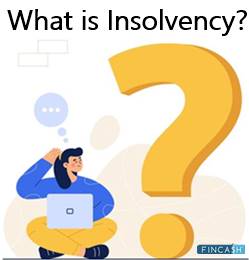
Table of Contents
What is Insolvency?
Insolvency refers to a state of Financial Stress where an individual or a company is unable to pay its debts that are due. It is often a result of poor cash-flow management, increased expenses or reduced cash inflow.

Before getting along with the insolvency proceedings, an insolvent person or business can set up informal arrangements with the creditors to restructure debts and pay them off. However, in case the insolvent can't be rescued, liquidation is the next process whereby an insolvent company is shut down, and its assets are distributed to the claimants.
Types of Insolvency
There are mainly two types of insolvency:
Factual Insolvency: This arises when the debtor's liabilities exceed their assets resulting in the inability to pay off the debts.
Commercial Insolvency: In this case, the debtors are unable to settle the debts despite the assets exceeding the liabilities.
The mere difference between these two types is whether the company or individual is solvent or not. However, this distinction becomes important to businesses as it works as an indication of whether the company can be rescued or not.
Talk to our investment specialist
Reasons for Insolvency
Several factors can lead to a person or company becoming insolvent. Some of the most common causes include:
- Inability to fine-tune and keep up with the current markets
- Loss of employment or salary reduction
- Financial mismanagement
- Increased vendor costs
- Fraud
Differences Between Insolvency and Bankruptcy
Unlike what most people believe, insolvency is not similar to Bankruptcy. It is a financial state in which a person or entity is unable to pay its bills or debts. A person becomes insolvent when the liabilities exceed the total assets.
On the other hand, bankruptcy is a court order that describes how an insolvent debtor will settle off their unpaid obligations. This usually includes selling assets to pay the creditors and removing the debts that can't be paid off.
Meanwhile, it is important to understand that a person or entity can be insolvent without being bankrupt (especially if the insolvency is temporary or rectifiable). However, if the situation extends longer than expected, it can ultimately lead to bankruptcy.
Insolvency Proceedings
In case a business is declared insolvent, it is best advised to consult an insolvency practitioner who can help you deal with insolvency proceedings. A professional can step into the court trials and determine a feasible way to bring the company back to a solvent state. Here, the main aim is to ensure that as much money is returned to the creditors as possible. Concerning this, the directors or shareholders can appeal for the following to the court:
- Administration: It involves the restructuring of the business to prevent further Depreciation of assets.
- Liquidation: Here, the company is officially shut down, and all its assets are distributed to claimants.
- Company Voluntary Arrangement: In this case, a contract is brought about regarding the payment of a debt after an agreement between the debtor and the creditors has been made.
- Receivership: Herein, a creditor or investor appoints an insolvency practitioner to manage the assets and pay off the possible debt amount.
Takeaway
Insolvency can cause more loss than expected and ultimately put an end to a well-established business. Hence, the best way to prevent insolvency is by mindful management of the finances, setting realistic budgets, staying up-to-date with the Market position, generating a cash buffer that you can access in case of a financial emergency.
All efforts have been made to ensure the information provided here is accurate. However, no guarantees are made regarding correctness of data. Please verify with scheme information document before making any investment.




